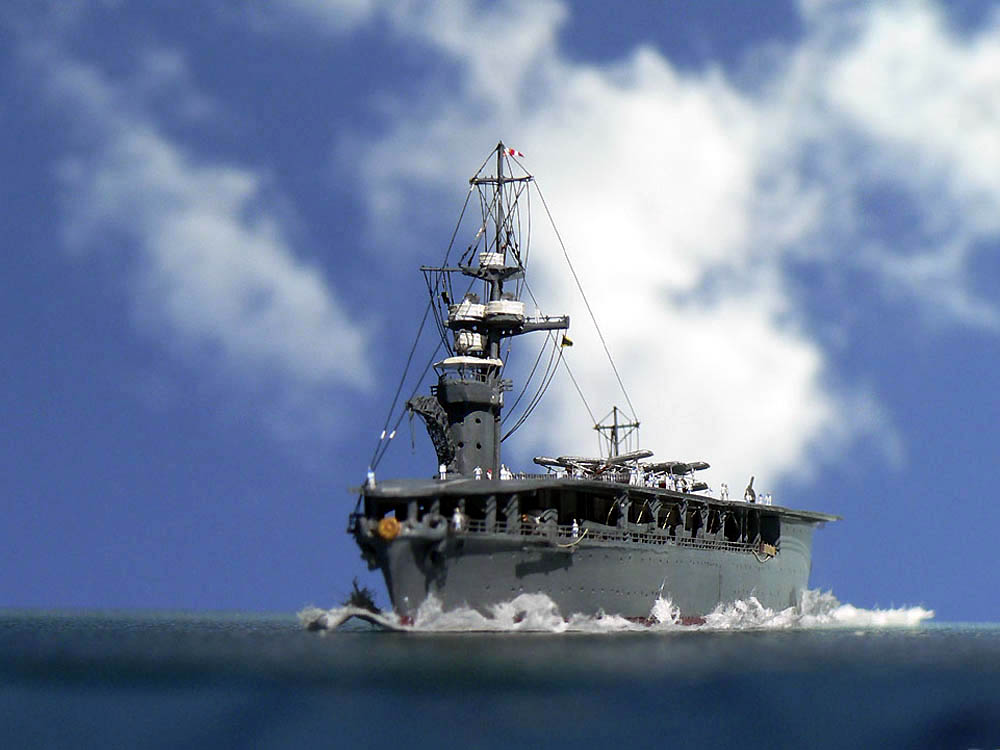by Lars Juel Mosbaek

1/700 IJN Hosho, 1923 (Fujimi)

Hosho (Japanese: , meaning "flying phoenix") was the first aircraft carrier of the Imperial Japanese Navy, and while not the first aircraft carrier, it was the first purpose-designed aircraft carrier to be commissioned. The hull was still based on a cruiser design, but it was not a conversion. Hosho was commissioned on 27 December 1922, thirteen months before the Royal Navy's first purpose-built carrier Hermes, which was designed before Hosho. There is some contention over this point, however, in that Hosho was originally conceived as a mixed aircraft carrier and seaplane tender and only during construction was her design modified to a dedicated carrier. She was the first purpose-designed aircraft carrier, but not the first purpose-designed dedicated aircraft carrier.
Being the first of its kind in the navy, Hosho was actively used to develop the aircraft carrier operational methods and tactics of the Japanese Navy during the 1920s.
Its design was originally based on a cruiser-style hull, a flight deck with a depressed fore-part to accelerate lift-off, a starboard island, and three starboard funnels that were reclinable during flight operations. After trials she was improved by removing the island and flattening the flight deck, giving her a flush-deck design.
It served during the Shanghai Incident (bombing of Shanghai on January 28, 1932) and Sino-Japanese War in 1937. In August-December 1937, Hosho supported land operations of the Japanese Army in China, as part of Carrier Division 1 with Ry j . Her aircraft complement consisted of nine Nakajima A2N fighters and six Yokosuka B3Y1 attack planes
By the beginning of World War II, Hosho had been superseded by other models: It was too small and too slow to accommodate the newest types of carrier planes such as the Mitsubishi Zero. She saw action however during the battle of Midway in June 1942, offering modest air support to the main fleet. Her aircraft complement consisted of eight Yokosuka B4Y1 'Jean' torpedo bombers.
For most of the postwar years, the assumption was made in English language publications that the ship had been equipped with a 'modern' aircraft complement by the time of the Midway operation, on the basis of minimal translations published in English. However, beginning in the 1980s English-language researchers realized that this was a bad assumption, as Japanese official histories and air orders of battle began to appear. It has now become clear that at the time of Midway, Hosho still carried a complement of the fixed landing gear biplane torpedo planes, the Yokosuka B4Y1 'Jean'. It was one of these aircraft which took the photos of the burning, drifting Hiryu in the late afternoon of June 4, 1942
Efforts were made to lengthen and widen its flight deck, but the overhang weakened her stability and ocean-going capability. It was relegated to training duty in Japan's inland sea after 1943
After the war, it was used as a transport to repatriate Japanese personnel from abroad until June 1946, before being dismantled in 1947. Hosho was one of four carriers of the Japanese Navy to survive the war, but would be scrapped in 1947. (From Wikipedia)
Technical specification:
Launched 13.Nov.1921 at Asano Dock, Yokosuka
Completed 27.Dec.1922
Decommissioned Jun. 1946
Dismantled in 1947
Displacement: 10,500 tons full load
Length: 168 m
Beam: 18.00 m
Draught: 6.17 m
Ship horsepower: 30,000 Shp.
Speed : 25 knots
Main guns 4 (4x1) 5.5´ = 14 cm, 50 caliber
AA guns 2 (2x1) 3´= 8 cm, 40 caliber
+ 2 machine guns
up to 26 aircraft
Crew: 550
Reference:
Books from my own library:
Samourai sur Porte-Avions par Michel Ledet (LELA PRESSE)
Gakken Perfect Guide, The Aircraft Carriers of the Imperial Japanese Navy and Army
Gakken no. 14 , Carrier strike force
Japanese Naval Warship Photo Album Aircraft carrier and seaplane carrier (Diamond book Japan)
Anatomy of the ship The Battleship FUSO by Janusz Skulski
